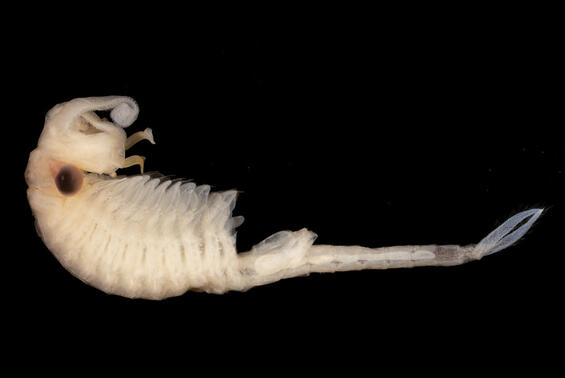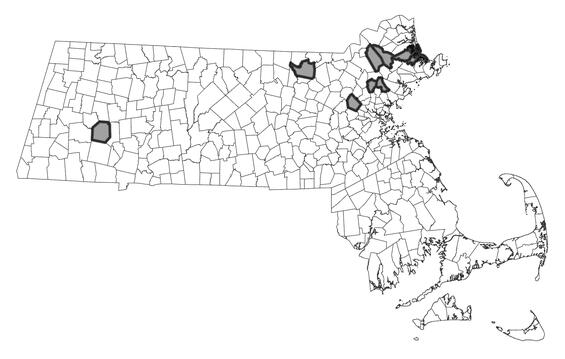- Scientific name: Eubranchipus intricatus
- Species of Greatest Conservation Need (MA State Wildlife Action Plan)
- Special Concern (MA Endangered Species Act)
Description

Intricate fairy shrimp (Eubranchipus intricatus)
The intricate fairy shrimp, also known as the smoothlip fairy shrimp, is a small, elongated crustacean. It is distinctly segmented with a series of paired, flattened, leaf-like appendages that resemble legs used for respiration and locomotion. This species is reddish-yellow or orange and as it matures, the orange color gets darker and the extremities become yellowish white. The head is enlarged with stalked compound eyes. The abdomen is long and tipped with two distinct tail-like structures. The adult reaches a length of 12-15 mm (~0.5-0.6 in) when fully grown. Males possess enlarged second antennae that function as claspers, holding females during mating. The males also have enlarged antennal appendages. Females lack the long appendages but they possess an obvious abdominal brood pouch (ovisac) where eggs are carried.
Two other species of fairy shrimp, the springtime fairy shrimp (Eubranchipus vernalis) and the knobbedlip fairy shrimp (E. bundyi), are known from Massachusetts and are quite similar to the intricate fairy shrimp. Both the intricate fairy shrimp and the springtime fairy shrimp have been found together in the same vernal pool. The primary differences between each of the three species are found in the male antennal appendage. The intricate fairy shrimp is most similar to the knobbedlip fairy shrimp in that it possesses elongate antennal appendages but with differences in clasper and labrum morphology. Descriptive accounts (Hartland-Rowe 1967, Kenney and Burne 2000) and identification guides (Smith 2000, Brtek and Mura 2000) sufficiently illustrate the differences among these species.
Life cycle and behavior
The intricate fairy shrimp has a short active life cycle from 1-2 months. Individuals hatch from resting encysted eggs which are actually developing embryos. The egg is enclosed in a dark covering designed to protect the embryo from heat, freezing, and periodic drying of the ponds. Once hatched, juveniles undergo rapid growth through several molts until the adult stage is reached. Adults molt several times and fertilization takes place just after the adult female molts. Female brood pouches have a pore through which the male injects sperm. Once the eggs are fertilized they are enclosed in a dark covering and the adult female carries them for a short period. The female releases the eggs, allowing her to mate again and produce several clutches during her lifespan (Smith 2000).Encysted egg has been observed to survive for five years, which may need certain levels of precipitation to stimulate hatching (Donald 1983).
The intricate fairy shrimp is a filter feeder, consuming phytoplankton, protozoans, and bacteria among other smaller organisms. It feeds on its back, filtering with rhythmic movements of its legs as it swims through the water. It is sensitive to vibration and light and will swim away from a person walking up to the edge of a pond.
Distribution and abundance
The intricate fairy shrimp range is recorded from several localities in Canada, and a disjunct distribution in United States from Montana to Wisconsin and in Vermont and Massachusetts. In Massachusetts, the species records are scattered throughout the state including observations west from the Westfield River watershed east to the Nashua and Ipswich River watersheds, and south to the Taunton River watershed.
The status of the intricate fairy shrimp in Massachusetts remains uncertain. It is the rarer member of its genus recorded in relatively small abundances but with evidence of reproduction activity. This species is listed under the Massachusetts Endangered Species Act as a Species of Special Concern. All listed species are protected from killing, collecting, possessing, or sale and from activities that would destroy habitat and thus directly or indirectly cause mortality or disrupt critical behaviors. In addition, listed animals are specifically protected from activities that disrupt nesting, breeding, feeding, or migration.

Distribution in Massachusetts.
1999-2024
Based on records in the Natural Heritage Database.
Habitat
In Massachusetts, this species is known as an inhabitant of vernal pools. These waterbodies are present at least during the late winter and spring, but usually dry at other times of the year. Such environments cannot support fish populations (i.e., predators) year-round and are used by mole salamanders, wood frogs, and other animals for breeding purposes. The intricate fairy shrimp is typically found in deeper, less ephemeral, and more bowl-shaped pools than the more often encountered springtime fairy shrimp (E. vernalis; D.G. Smith, personal communication 2003).
Healthy habitats are vital for supporting native wildlife and plants. Explore habitats and learn about conservation and restoration in Massachusetts.
Relatively deep vernal pool habitat.
Threats
Ponds that support the intricate fairy shrimp and other fairy shrimp species are ephemeral and are usually dry many months of the year, making these aquatic habitats easy to overlook. Loss of ephemeral ponds due to development is the most obvious threat to this species. Changes in hydrology that interfere with the length and timing of pool inundation are threats to existing populations. Pollutants moving through groundwater in the vicinity of temporary ponds also represent possible threats. Forest cutting, intentional stocking of fish during wet periods, and excavations of basins containing vernal pools are additional concerns.
Conservation
Survey and monitoring
Standardized surveys are needed to update the population status of intricate fairy shrimp at its historical sites. Survey effort should also target unsampled vernal pools with physical features that may support intricate fairy shrimp; its likely the species occurs in other watersheds across the state. Surveys should target adults when vernal pools are filled in late winter and spring and may require multiple sampling events for positive detection. Monitoring efforts are recommended at least every 5-10 years or as needed to the extent practical (e.g., in response to potential disturbance or stressor events) at high-quality sites.
Management
Protection of vernal pool habitat is critical to maintaining intricate fairy shrimp populations on the Massachusetts landscape. Protection of riparian areas and associated uplands should a priority to maintain water quality and quantity. Prevention and control of invasive riparian plant species may also be warranted. Alternatives to commonly applied road salts should tested to minimize freshwater salinization.
Research needs
Surveys should continue to target historical but also identify new vernal pools to better understand its distribution, relative abundance, and habitat requirements in Massachusetts. Physical surveys coupled with eDNA collections could improve species detection, assuming species DNA markers are developed. Other research needed for this species include identification of environmental thresholds that trigger cyst hatching including precipitation amounts and water temperature. Increased knowledge of the longevity and size of cyst banks and genetic isolation of populations would also inform population stability and risks to environmental stressors.
References
Brtek, J., and G. Mura. 2000. Revised key to families and genera of the Anostraca with notes on their geographic distribution. Crustaceana 73 (9): 1037-1088.
Donald, D.B. 1983. Erratic occurrence of anostracans in a temporary pond: colonization and extinction or adaptation to variations in annual weather? Canadian Journal of Zoology 61(7):1492-1498.
Kenney, L., and M. R. Burne. 2000. A Field Guide to the Animals of Vernal Pools. Massachusetts Division of Fisheries and Wildlife Natural Heritage and Endangered Species Program & Vernal Pool Association. Westborough, MA. 73 pp.
Hartland-Rowe, R. 1967. Eubranchipus intricatus n. sp., a widely distributed North American fairy-shrimp, with a note on its ecology. Canadian Journal of Zoology 45: 663-666.
Smith, D.G. 2000. Keys to the Freshwater Macroinvertebrates of southern New England. Published by author. Sunderland, MA 243 pp.
Contact
| Date published: | March 10, 2025 |
|---|